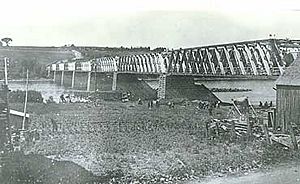Hartland Covered Bridge facts for kids
Quick facts for kids Hartland Covered Bridge |
|
|---|---|

Hartland Bridge, from the Somerville side looking back toward Hartland.
|
|
| Coordinates | 46°17′48″N 67°31′49″W / 46.29667°N 67.53028°W |
| Crosses | Saint John River |
| Locale | Hartland-Somerville, New Brunswick |
| Characteristics | |
| Design | Howe truss covered bridge |
| Material | concrete (piers) wood (truss) |
| Total length | 1,282 feet (391 m) |
| Number of spans | 7 |
| Piers in water | 5 |
| Load limit | 10 tonnes (9.8 long tons; 11 short tons) |
| History | |
| Construction begin | 1898 |
| Construction end | May 14, 1901 |
| Construction cost | $33,000 |
| Opened | May 13, 1901 |
| Inaugurated | July 4, 1901 |
| Replaces | Hartland ferry, Ice bridge |
| Official name: Hartland Covered Bridge National Historic Site of Canada | |
| Designated: | 1980 |
| Type: | Provincial Heritage Place |
| Designated: | 1999 |
The Hartland Covered Bridge in Hartland, New Brunswick, is the world's longest covered bridge. It stretches an amazing 1,282 feet (391 m) (390.75 meters) across the Saint John River. This famous bridge connects the towns of Hartland and Somerville in Canada. It is made up of seven smaller Howe Truss bridges joined together on six strong supports called piers.
Contents
Building the World's Longest Covered Bridge
Before this amazing bridge was built, people crossed the Saint John River by ferry. Sometimes, in winter, they used an ice bridge when the river froze. Plans for the Hartland Bridge started in 1898. The Hartland Bridge Company built it, and it was finished in 1901.
On May 13, 1901, Dr. Estey became the first person to cross the bridge. He had an emergency call to answer. Workers quickly placed planks so he could drive his horse and buggy over. The bridge officially opened on July 4, 1901. About 2,000 people gathered to celebrate this big event.
From Tolls to Public Ownership
At first, people had to pay a small fee, called a toll, to cross the bridge. This money helped pay for its construction and upkeep. However, the provincial government bought the bridge on May 1, 1906. After that, people could cross for free.
Challenges and Changes Over Time
The bridge has faced several challenges throughout its history. In 1907, a fire damaged some parts of the structure. Luckily, it did not destroy the entire bridge.
A major event happened on April 6, 1920. Two sections of the bridge collapsed because of heavy river ice. After repairs, the bridge reopened in 1922. This is when the bridge was finally covered, even though some local people didn't want it to be. The original wooden supports were also replaced with stronger concrete ones.
In 1945, a special walkway for people to walk safely was added to the bridge. The Hartland Covered Bridge was recognized as a National Historic Site in 1980. It also became a Provincial Historic Site in 1999.
Recent Repairs and Recognition
The bridge has needed repairs a few times since then. In 1982, a car hit a steel beam, causing part of the bridge to drop. It was fixed and reopened in 1983. In 2006, a small piece of wood from the bridge was used in the Six String Nation project. This project created a special guitar called Voyageur.
In 2007, the bridge closed again because a main beam split. It was repaired and reopened. On July 4, 2012, Google celebrated the bridge's 111th anniversary. They featured it with a special Google Doodle on their Canadian homepage.
Fun Facts and Legends
The Hartland Covered Bridge has some fun stories and traditions. When people used to cross by horse and wagon, couples would often stop halfway. They would share a kiss there, giving the bridge the nickname "Kissing Bridge."
The first wedding on the bridge happened in September 1992. Charmaine Laffoley and Dana Hunt from Toronto got married right on the bridge! Some local people believe it's good luck to hold your breath while driving all the way across.
Bridge Features and Location
The Hartland Covered Bridge is located in western New Brunswick, in southeastern Canada. It connects the town of Hartland on the east side with Somerville on the west. The bridge crosses the Saint John River just south of Middle Becaguimec Island.
Since the Hugh John Flemming Bridge was built in 1960, the Hartland Bridge is mainly used for local traffic and tourists. It's a popular spot for visitors to see the world's longest covered bridge.
How Big is the Bridge?
The Hartland Bridge is 390.75 metres (1,282.0 ft) long. This makes it the longest covered bridge in the entire world! It's also the longest covered bridge ever built in Canada. Another long Canadian covered bridge was on the Batiscan River in Quebec. It was 377 metres (1,237 ft) long and used from 1844 to 1870.
Other very long covered bridges have existed elsewhere. For example, the Columbia–Wrightsville Bridge in Pennsylvania was built in 1814. It was 1,524 metres (5,000 ft) long and crossed the Susquehanna River. However, it was destroyed in 1863 during the American Civil War.
The Hartland Bridge has only one lane for vehicles. It can only be used by vehicles weighing less than 10 tonnes. Also, vehicles must be shorter than 4.20 metres (13.8 ft) to pass through. There's also a special covered walkway on the south side of the bridge for people walking.



